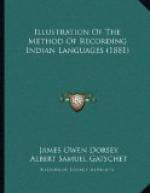583, 3. tch[e]l[x]a. During the treatment of a patient, who stays in a winter house, the lodge is often shut up at the top, and the people sit in a circle inside in utter darkness.
583, 5. liuki[a]mnank. The women and all who take a part in the chorus usually sit in a circle around the conjurer and his assistant; the suffix -mna indicates close proximity. Nadsh[=a]’shak qualifies the verb win[o]ta.
583, 5. tch[^u]tchtn[i]shash. The distributive form of tch[^u]’t[’]na refers to each of the _various_ manipulations performed by the conjurer on the patient.
584, 1. m[=a]’shish, shortened from m[=a]sh[i]pkash, m[=a]’shipksh, like [k=]’l[:a]’ksh from k[’]l[:a]k[a]pkash.
584, 2. 3. There is a stylistic incongruity in using the distributive form, only in kuku[`a]ga (k[u]e, _frog_), k[a]haktok, and in nshendshk[a]ne (nshek[a]ni, npsh[e]kani, ts[e]kani, tch[e]k[)e]ni, _small_), while inserting the absolute form in wishink[a]ga (w[i]shink, _garter-snake_) and in [k=][a][k=]o; m[^u]’lkaga is more of a generic term and its distributive form is therefore not in use.
583, 2. k[a]haktok for k[a]-akt ak; k[a]-akt being the transposed distributive form k[a]kat, of k[a]t, which, what (pron. relat.).
584, 4. lg[^u]’m. The application of remedial drugs is very unfrequent in this tribe; and this is one of the reasons why the term “conjurer” or “shaman” will prove to be a better name for the medicine man than that of “Indian doctor”.
584, 4. k[^u]’tash etc. The conjurer introduces a louse into the eye to make it eat up the protruding white portion of the sore eye.
K[A]LAK.
THE RELAPSE.
IN THE KLAMATH LAKE DIALECT BY DAVE HILL. OBTAINED BY A.S. GATSCHET.
H[:a]|n[a]y[:a]ns|hissu[a]ksas|m[=a]’shitk
|k[a]lak,|ts[u]i|k[i]uks| When | another | man | fell sick | as | then | the | relapsed, conjurer
|n[:a]’-ulakta|tchu- | concludes | to
t[a]nuapkuk.|Tch[u]i|tch[u]ta;|tch[u]i|y[
a]-uks|huk |shl[:a][a]| treat (him).| And | he | and | remedy |this| finds out | treats;
|k[a]lak a g[=e]k. | Tchi |(that) relapsed he.| Thus
huk|shu[^i]’sh|s[a]pa.|Ts[u]i|n[=a]’
sh|shu[=i]’sh|s[a]yuaks| the| song- | indi- | And | one | song- | having | remedy cates. remedy found out
|h[^u]’mtcha k[a]lak,|tch[u]i 3 | (that) of the kind | then of relapsed (he is),
n[a]nuk|h[^u]k|shu[=i]’sh|tp[:a]’wa|h[^u
]’nksht|kaltchitch[i]kshash| all | those| remedies | indicate|(that) him |the spider(-remedy) |
|heshuamp[)e]l[i]tki | would




